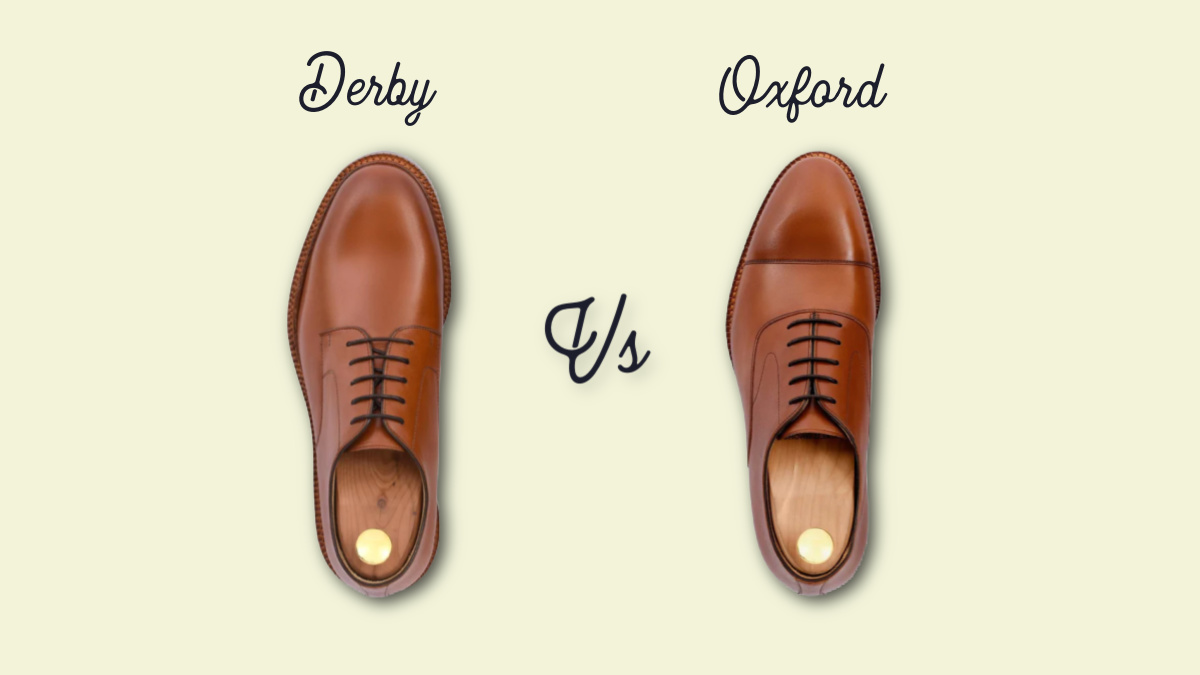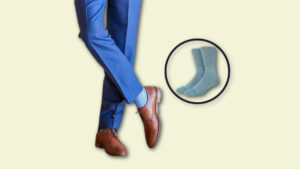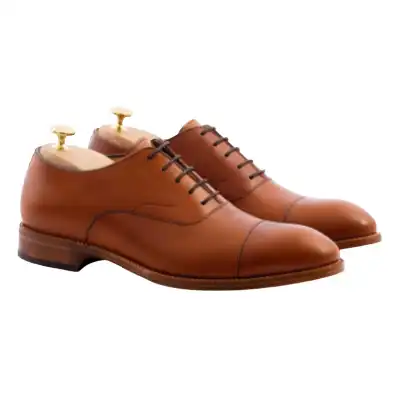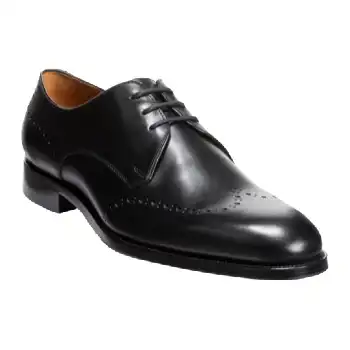Oxfords have closed lacing, meaning the eyelet tabs are sewn beneath the vamp, also tucking the tongue under. Meanwhile, Derbys have open lacing, so the eyelet tabs are sewn over the vamp, connecting the tongue with the vamp, and providing an extra layer to the surface. Oxfords are generally more formal.
Oxford shoes and Derby shoes.
They’re like the Manning brothers.
They’re clearly related, showcasing a lot of the same looks, functions, and capabilities. But, there are certain expectations and needs that you’d rather turn to one sibling for over the other. And vice versa, of course.
So when it comes to fashion, when should you go for a Derby? When should you go for an Oxford?
To answer those questions and more, we’re going to break down the differences between these two quintessential dress shoes.
Table of Contents
What’s the Difference between Oxfords and Derbys?
The defining difference between Oxford and Derby shoes is all about the laces. Well, the lacing system, really.
Oxford shoes have closed lacing. This means that the eyelet tabs (the holes that you string your laces in and out of), are sewn beneath the vamp, for a smoother silhouette and thinner fit.
Meanwhile, Derby shoes have an open lacing system, meaning that the shoe eyelet tabs are sewn over the vamp, creating an extra layer on the surface of the shoe. Therefore, Derbys have a more topographical silhouette. I wouldn’t call it a bumpy shape, per se, but there’s just more going on compared to the surface of Oxford shoes.
So, the seams running directly beneath the laces of Oxford shoes are embedded onto the surface, while the equivalent seams sit on an upper tier of leather on a Derby.
Now what does this mean when it comes to style or function? In general, Oxfords are more formal, but the devil is in the details.
Oxfords
Though Oxfords are overall considered to be dressier than Derbys, additional features like broguing and cap-toes make this categorization highly variable.
Another reason they’re considered more formal is because, supposedly, they were worn by students at Oxford University in the 1800s. This gives them a more academic lore. Naturally, Oxford shoes are associated with professors, educated professionals, and suit guys in general.
Other defining physical features of Oxfords include an exposed ankle, often a stitched leather sole with a low heel, and a tongue that’s stitched separately underneath the vamp since the tongue also sits beneath the tucked-in eyestay tabs.
When to Wear an Oxford
A cap-toe Oxford is the perfect professional shoe. Its slim shape is formal enough to go with a full proper suit, but the extra detailing gives it a practical aesthetic.
The most formal version is the wholecut Oxford. There’s zero detail since it’s made out of one piece of leather. This goes best with tuxedos, but you can also wear it with black or dark navy tuxedos in semi-formal situations.
And despite the fact that Oxford is associated with formal and business dress, you can actually wear it casually.
Paired with a henley shirt and fitted jeans? Perfect. Just don’t go wearing an Oxford with sweatpants or any athletic wear. Basically, if the casual outfit is clean-lined and neat, you’re good to go.
My Favorite Oxford: Beckett Simonon Dean Oxford
One of the things I really love about the Beckett Simonon Deans, aside from its refined silhouette and supple leather construction, is the fact they’re incredibly comfortable.
They’re Blake-stitched, which isn’t as easy to resole as Goodyear-welted shoes, but they offer support, structure, and a short break-in period.
Other topnotch details include the rubber cap on the handsome heeled outsole, which provides traction, and the five available colorways.
Depending on which version you go for, these shoes can go with basically any outfit, from chinos and jeans, to suits and tuxedos.
The Beckett Simonon Deans are full-grain leather Oxfords that boast a high level of hands-on craftsmanship. At often ~$200, these classic, slim shoes fly miles over their price point. Oh, and they’re also super comfortable, to boot.
Derbys
Just as the university association makes Oxfords more formal, the equally as spotty origin of Derby Shoes make them more of a workhorse—as far as dress shoes go.
They either started as hunting shoes for the countryside gentleman in the 19th century, or as an evolution from Oxfords inspired by Field Marshal Gebhard Leberecht von Blücher. During one of the Napoleonic wars, he wanted footwear that was more comfortable and classier than the big boots his troops wore.
Either way, it has a utilitarian association, which makes sense since the open lacing system gives your foot more stretch and mobility.
Actually, another origin story includes the 14th Earl of Derby who had his namesake design commissioned for his wide feet and high insteps. Derby shoes are generally easier to take on and off, so perhaps there’s some truth to that story though.
Other physical features of Derby shoes include, often, a more rounded toe, and a seamless relationship between the tongue and the vamp. The tongue and the vamp are part of one piece, while the eyelet stay tabs are almost like each side of a vest.
When to Wear a Derby
Most Derbys can also be worn with a suit, though the only kind I’d wear with a tuxedo are simple, dark leather versions. No broguing, no cap toes, no details at all. Patent leather would also balance out the workhorse quality of the open lacing system.
Other than that, you can basically wear a Derby shoe with any casual combination as well, including jeans and chinos.
If you’re a trendier gent or love workwear, you can even wear the clunkier, highly-detailed variations in the same way you’d wear a combat boot. Combine them with, say, a chore coat and fitted work pants.
And like the Earl of Derby (probably), you should go for a Derby if you have wider feet or a higher instep.
My Favorite Derby: Allen Edmonds Lucca Derby
Any broguing might be too fanciful for some tastes. However, the Allen Edmonds Lucca Derbys are an excellent example of how broguing and relatively thick open eyestays don’t necessarily take away from a dress shoe’s sleekness.
The eyestay tabs aren’t too thick and don’t interrupt the silhouette at all. They’re also pretty close to each other, making the surface look less variegated. Meanwhile, the broguing happens on solid surface, versus at stitched areas where pieces of leather meet.
It’s slim, modern, and chic, and can be worn more formally than the average brogued Derby, without taking away from its casual versatility.
The Lucca Derby from Allen Edmonds is truly distinct, thanks to its slim eyestay tabs and tempered broguing. This allows you to go more formal with them than most detailed Derbys. Construction-wise, they’re made with full-grain Italian leather and are flexibly Blake-stitch
Oxford vs Derby: Which Shoe Is Best for You?
Overall, the closed lacing system of the Oxford shoe makes it dressier than the open lacing system of the Derby. All things held equal, the extra tier of leather makes Derbys more detailed looking.
It is all about the details though. A simple, slim Derby might look way more formal than an Oxford with tons of broguing and a circular toe.
In a lot of ways, you’ll know it when you see it. And now, you’ll know an Oxford from a Derby when you see it.
FAQs
Which is better: Oxford or Derby shoes?
It depends what you’re looking for. Oxfords are slimmer and therefore more versatile with more formal and professional outfits, while Derbys are more versatile in the more casual end of the spectrum.
Is a Derby or Oxford more comfortable?
It depends more on the sole system, but in general, when it comes to an Oxford and Derby that are otherwise similarly-built, the wide fit of the Derby makes it more comfortable.
Is Derby or Oxford better for tuxedo?
Oxfords are simpler and therefore more formal, with whole-cut versions being the best options for a tuxedo over any Derby.





Join the Discussion